Angels With The Iron Fist, The Golden Buddha, The Singing Thief (1966, 1967, 1969)
Directed by: Chang Cheh, Lo Wei
Written by: Chiu Kang-Chien, Shih Wei
Starring: Chung Cheng, Fanny Fan Lai, Jeanette Lin Tsui, Lily Ho, Lin Chong, Paul Chang Chung
SUPER SPIES AND SECRET LIES: Three Undercover Classics from Shaw Brothers [1966, 1967, 1969]
AVAILABLE ON BLU-RAY: NOW, from EUREKA ENTERTAINMENT
REVIEWED BY: Dr Lenera
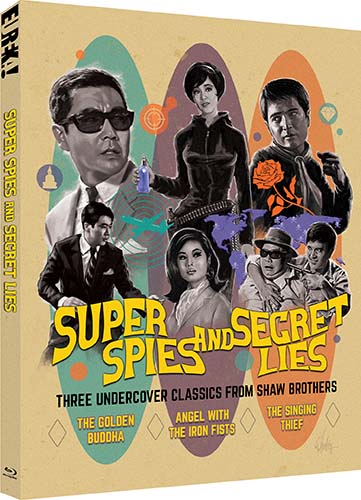
DISC ONE
THE GOLDEN BUDDHA [1966]
AKA JIN Pi SA
RUNNING TIME: 104 mins
 Businessman Paul accidently picks up the wrong briefcase on a trip from Hong Kong to Bangkok but doesn’t realise this until he’s in his hotel room. Letters, not to mention a small gold Buddha, reveals that his old friend Chung Cheung was involved in some plot whereupon three Buddhas together reveal the location of some treasure. Paul finds Chung again, but this time he’s dead. The deadly Skeleton Gang are also after the treasure, and therefore the Buddhas, and will stop at nothing. Paul decides to track down the owners of the other Buddhas, who are Chung Tai Chan and his niece Mei-Nan….
Businessman Paul accidently picks up the wrong briefcase on a trip from Hong Kong to Bangkok but doesn’t realise this until he’s in his hotel room. Letters, not to mention a small gold Buddha, reveals that his old friend Chung Cheung was involved in some plot whereupon three Buddhas together reveal the location of some treasure. Paul finds Chung again, but this time he’s dead. The deadly Skeleton Gang are also after the treasure, and therefore the Buddhas, and will stop at nothing. Paul decides to track down the owners of the other Buddhas, who are Chung Tai Chan and his niece Mei-Nan….

Way, way before the superhero craze was another one, one that may not have lasted as long in terms of being a huge “thing”, but which possibly dominated popular culture even more strongly. Spies. 007 has remained popular even up to today, but the effect that the first Bonds had probably can’t be overstated. Of course a lot of us weren’t around then [though I wish I was] but a cursory look at the amount of movies and TV shows that came out during the ’60s will reveal an absolutely huge amount of product which wouldn’t exist if it wasn’t for Bond. Bondmania swept the globe, and many countries tried to get in on the act. After the US and the UK, it was probably Italy who produced the most spy movies, or at least the ones that traveled most, and even got Sean Connery’s brother to appear in one called OK Connery with some Bond alumni. However, the Far East also contributed their fair share, including of course Hong Kong’s legendary Shaw Brothers, though they weren’t seen much outside of Asia. Eureka offer three. This first one has elements that you’d probably expect, such as a supervillain in a lair with identically clad minions, and a good girl and a bad girl for our lady-liking hero to contend with, but uses them to freshen up what’s essentially a rather traditional treasure hunt tale, with our hero not an actual spy but a normal guy mistakenly caught up in intrigue and danger Alfred Hitchcock-style which revolving round a Macguffin. Unable to give us big scenes with lots of extras, the studio makes up for this by making The Golden Buddha visually interesting throughout with its ancient and modern Thai locations contrasting with some striking set design, while the pace keeps going even if the action mostly consists of mediocre Karate and Judo fight scenes; a few years later they’d have no doubt been a lot better.
We’re just outside Hong Kong airport. “I’ll call first thing after I get to Singapore”, says our hero to his girlfriend who’s dropped him off, which we already suspect will be a lie. “Once you’ve done with your investigations in Singapore, send me a wire right away” says another guy to him, who may or may not his boss, it’s not made clear, while these “investigations” constitute some sort of business deal. Anyway, as soon as he’s on the plane the air hostess moves his suitcase because apparently he’s not supposed to have it high up, which just seems like an obvious plot device to me. The suitcase is now stored in an area on the floor further away, which is just asking for trouble if somebody else has one just the same. Paul notices that sitting the other side from him is Chung, an old mate from his Judo club; they joke about fighting on the plain, then Chung says that he’s on his way to Thailand because his brother has sent him a letter telling him to come because there’s an “emergency”. Paul proudly says that he’s now learning Karate, which was obviously put in just so his ability to repeatedly defeat opponents didn’t seem so ridiculous even though he’s not a secret agent. In his hotel room, Paul opens the suitcase that he’s picked up and is surprised by its contents, which include a little Buddha statue, a good moment for the film’s title to appear onscreen! Chung told him that he’d gone to a massage parlour, but he’s not there when the place is visited by Paul, who has to flee some very keen young ladies. The owner gives him Paul’s address, and Paul finds him sat at his desk with s knife in his stomach. This is a weird moment. Why? Because Paul barely reacts. Surely he’d be shocked and upset even if this guy wasn’t someone he was really close to?
Chung had been writing, “Deliver golden buddha after meeting Chan Chung Tai and Chan Mei-Nan” before he’d been interrupted, which was convenient, though not as convenient as another letter Paul finds where Chung had jotted down about discovering “Where the Chans buried their treasure, the location is on the three Buddhas kept by you, Mei-nan and myself. Please return with the golden Buddha, then we’ll proceed with the digging, your brother Tai”. Then two goons show up, and the first of many fights takes place. Paul seems to take his friend’s place without much thinking about it; I get that the film was intended to keep moving, but it seems silly how suddenly he becomes such a confident, able hero. After doing some asking in a tattoo parlour, the police show up and tell him not to leave the city, then do little else. We sort of expect that there’ll be scenes of the cops chasing him about, but we don’t get any. They don’t even suspect him of murdering Chung! All they do from now on is hang around nearby and pretend that they’re reading newspapers. Paul is therefore able to do what he wants with no hindrance from them, which is to find those other two Buddha owners – Mei-Nan Chan and her uncle Chung Tai – who are also having problems with the same gang, the Skeleton [why are they called that?] Gang, that’s bothering Paul, and figure out a riddle which might just reveal the location. Paul first comes into contact with an unnamed female operative who initially fools Paul into thinking that she’s Mei-Nun, then acts very blatantly sexual indeed. Fanny Fan Lai, here playing basically Shaw’s version of Luciano Paluzzi’s Fiona Volpe from Thunderball, oozes carnality in the role. Of course Jeanette Lin Tsui as Mei-nan is deliberately designed to be a contrast, though she’s not a particularly capable character except for smashing a vase over a bad guy’s head right near the end.
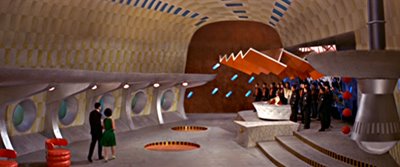
Eventually we do meet our main villain and he’s just great, clad in a gold foil suit with a large collar, a black cape also with a large collar, and yellow sunglasses. I’m not going to tell you who he’s played by, because it might ruin a supposed surprise in the story, a revelation that went on to be used in a later Bond film not that far off. His henchmen when in the lair look all neat clad in red shirts, black jackets and black trousers. Early on they send Paul a note which says WE CAN TAKE YOUR LIFE AT ANY TIME, but they barely seem capable of tying their own shoelaces. They’re pretty incompetent throughout and it’s a wonder that their leader puts up with any of them seeing as we see him execute one of his minions who at least did their very best, which is of course recalling a scene from Thunderball; later on, when things switch to inside the lair, Dr No is recalled. He bafflingly orders them to attack Paul in twos rather than en masse, similar to the way that fool Han ordered his men to go for Bruce Lee and John Saxon in tiny groups rather than altogether which in both cases would have seemed like the more sensible thing to do. But then it’s also hard to imagine why such a supervillain, who owns and controls so much, would be so much after this treasure which surely should seem of little worth to him. The many brawls have the actors and their stuntmen flinging themselves all over the place with considerable energy and enthusiasm, but they aren’t very well choreographed. Punches rarely look like they’re hitting their targets and people rarely look like they’re being hit. And a somewhat bland – despite walking about like Sean Connery – Paul Chang Chung as Paul only sometimes looks convincing in the fights, though you’ve got to love the bit where he strokes a villain’s head before knocking him out.
Blood is almost absent, though we get some brief and totally gratuitous nudity. Were Shaw Brothers unsure of what audience they were going for? There are an inordinate amount of out of focus shots, proving that the filming of this movie really was something of a rush job; after all, cinematographer Shao-Liang Tung does some genuinely good work elsewhere. For over an hour we’re mostly offered a combination of old and new locales, then we get more of the typical very artificial-looking but pleasing Shaw sets, including a garden one which looks like a redressed version of one of their familiar ones we see in many of the martial arts films, though it might not because the Kung Fu boom hadn’t really picked up yet. A graveyard set is rather beautiful. Then there’s the very odd nightclub that some of the characters go to, with lots of huge oval holes in the walls through which one can see other tables. And then we get to the Skeleton Gang’s lair, where the set designers seem to have asked to just do whatever the hell they wanted in what should be held up as a great example of ’60s chic, combining elements of many of the secret bases and bachelor pads that we’ve seen in films from that decade, and all with what would probably have been no more than lunch money for Ken Adam. Then there’s the music score, credited to an “Eddie Yang” whose job was probably just to seek out and use tracks by others, which re-uses bits of the John Barry soundtracks to Thunderball and The Knack. It’s weird hearing music previously used in an underwater sequence applied to footage of people walking about on land, though it usually works quite well, as do the other tracks used. The opening track sounds like it more belongs in the ’50, while the piece sort of employed as a love theme has a western tinge but is quite lovely.
Despite, after a memorable chase around some very familiar ruins which combines the picturesque and the thrilling rather well, a pretty underpowered climax which makes me wonder if the money ran out [those set designers probably used it all up], The Golden Buddha is a slightly awkward but pretty fun romp which certainly has its own aesthetic.
New audio commentary by action cinema experts Mike Leeder and Arne Venema
Eureka stalwarts Leeder and Venema have their work cut out for them with this set, because they haven’t got Frank Djeng to provide an alternative track; they’re on their own. And, certainly on the basis of this track, they deliver, providing lots of insightful, knowledgeable yet light and banter-filled commentary – even though they seem to have done Angels With The Iron Fist, the second film on this disc, before this one. What’s particularly interesting is that Venema probably says more than Leeder in this one, be it giving us information about the locations old and new, including Ka Tek airport being hard for pilots who often have to turn over a school amidst strong winds which can dangerously push them towards mountains, the real golden Buddha which was revealed as being made out of gold when it was accidently dropped and smashed revealing the gold in the interior, as well as telling us that he once visited a bizarre MacDonald’s in the middle of the jungle. Meanwhile Leeder tells of Thailand having two levels of trains – one or poor and one for rich folk, Bob Monkhouse getting arrested for having video recordings of his own shows, and mistakes a scene in Thunderball for being in Dr No, though their love for the Bond films is evident and appropriate. Really great stuff!
ANGELS WITH THE IRON FIST
AKA TIE GUAN YIN [1967]
RUNNING TIME: 122 mins
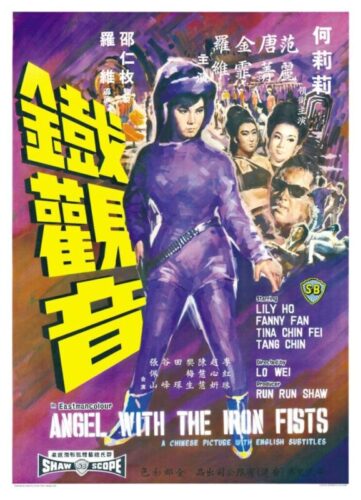
In Hong Kong, a man is shot by several others and his briefcase taken. Soon after, a lady named Luo No, who possesses a seemingly valuable box of jewelry, arrives in Hong Kong and immediately attracts the attention of both the local police and the villainous Dark Angel gang, especially Cheng Tei-he, who’s immediately taken with her, something that displeases his actual girlfriend Dolly. It seems that Luo was once the mistress of currently imprisoned gangster Baldy and may have ran away with his money. The Dark Angel leader learns of all this and, suitably impressed, decides that she could do with the resourceful Luo in her gang and decides to test her. But what is she really up to?

Made soon after The Golden Buddha with some of the same team, you’d think that Wei and company would use the opportunity to improve on it, and they do seem to have been given a bigger budget for their second go around at Bondsploitation, though the result is very uneven. There’s some real fun stuff in it, to be sure, but every now and again Wei, whether he was also the screenwriter or not, managed to make a film which for some reason would stretch out its plot rather too much, and this is certainly one of them; the first half, which is mostly taken up with our heroine trying to convince our villains that she is who she says she is, really didn’t need to be anywhere near as long as it is, and certain scenes take ages, which I guess is fine if you’re a really good filmmaker with artistry to spare, but not if you’re Wei, whose films do sometimes show aspirations and even some experimentation, but which are often very uneven and at times seem to show a director who didn’t care much – though at at least this one isn’t full of out of focus shots. Will the real Lo Wei stand up? I guess it depended on whether the horseracing was on the radio or not. Less visually diverse and interesting than its predecessor though still generally appealing to look it, it has fight scenes which are rather different, being less athletic and martial arts-heavy though a little more convincing; which you prefer will be down to your taste but you’ll probably agree that in neither film are the brawls particularly good. Hell, some of the fight scenes in the early Bonds were better. Nonetheless, Angels With The Iron Fist, while it has to give its heroine a male companion to majorly help her out, is notable as an example of the female-dominated action film which was already something of a thing in many Asian countries, and it showcases its three main actresses, who all deliver, well.
It’s night time and a man walking fight in the middle of the road realises that he’s being followed; he starts to run, but is intercepted by three cars and gunned down, each guy firing at once, while in a telephone box. One of the many bad guys takes the dead guy’s briefcase and gives it to a lady who we later realise is the leader of this lethal [well, not really, much like the Skeleton Gang] gang known as the Dark Angels. They really don’t like giving proper names to everyone in these films. Now come the titles, which also clearly bear the influence of Dr No. At Hong Kong airport, three guys see the arrival of “the new agent from London” [of all places, this is never explained] who’s met by a few police . “Looks like the detective is treating him like treasure”. “What treasure, just looks like another agent for us to kill” is the reply from the Dark Angel leader, who only sees her from a great distance. Said “treasure” takes a taxi to her hotel, getting a great proper reveal when she asks her driver for a cigarette. Her driver is actually a Dark Angel minion who tells his boss that she has a locket which shows her with an imprisoned crime boss named Baldy. In a nightclub [not as bizarre as the one in the last film but still a place with some eyepopping design], two Dark Angel hoods notice her. Dark Angel Cheng Tei-he holds back on approaching her, and not just because his singer girlfriend Dolly is around. His companion is rather forceful and Tei-he goes to help, resulting in him fighting with several thugs while she just watches, then escorting her to her hotel telling the bar staff “put all the damages on my bill”. 007 never seemed to care about such things.
Wei would sometimes over-complicate his plots, and here his screenwriter introduces a box of jewelry which Loa Na possesses; the intrigue involving this box which people want just isn’t necessary, if you think about the storyline, which would have worked fine without it with a few relatively minor adjustments, unless said jewelry box is really the money thar Lo is supposed to have run away from Baldy with, rather than share it with his henchmen – but then the subtitles should have described it as such. There’s clearly an attraction between Loa Na and Tei-he, but he’s taken, and Dolly is also a Dark Angel; their first private scene together showing the first of the many gadgets in this film, a recording device which may seem unimpressive now but wait until you see what’s to follow. That night, Loa Na leaves her hotel the back way to snoop around the house of somebody I’m not sure; somewhat typically, the script is vague on a few things yet we have scenes that aren’t really necessary or which go on for too long. Loa Na encounters more villains here, then she and Tei-he are suddenly transporting this jewelry somewhere while disguised as undertakers, leading to a car chase which took me a short while to realise exactly who all the participants in it were. But now we see the villain’s base, considerably earlier than in The Golden Buddha, and the leader appearing high above to address her minions. She wants to recruit Loa Na and is willing to put pressure on her so she’ll play ball, while Loa also also has Tei-He to contend with – not to mention an understandably jealous Dolly, who overhears some talk which she’s rather hurt by. It’s eventually revealed that she’s really a vengeful agent working for the Chief Detective [Wei, of course] whose simple advice to her is “find out where their headquarters is and blow it up”.
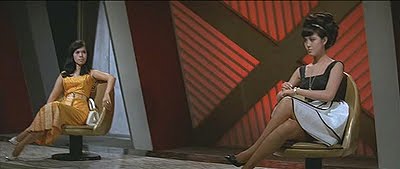
Of course that’s a very good idea seeing what these nasties are really up to, but Tei-He has to train her to be an assassin from his side. The weird thing is that a lot of this seems rather rushed, not given enough time, yet once we’re inside the baddie lair – where of course all the women are scantily clad – we’re treated to endless footage of villains moving around in formations. Wei sure was an odd director, and not always in a good way, And odd behavioiur is almost the name of the game here, at least as far as the villainous side of things is concerned. As before, the gang members are lousy at their job, but then also why does Loa Na do things like only pull a gun on three bad guys when she’s already fought them for about half a minute? And, as for the villainous Leader, she’s rather careless the way that he tells specific details, right down to the flight numbers, of his top-secret plan to do something very bad right in front of her most recent recruit, immediately following her initiation, but then the perhaps even more careless Chief Detective discusses plans with Loa while a doctor and three nurses are present. They then also witness a ‘Q’ branch-like scene where Loa Na is presented with some gadgets including a purse that fires bullets, a watch with timebombs inside that can stick to any surface, and a hairband containing a gem stone that sends out signals. There’s more chasing than before, including one bit by car and motorbike featuring a daft moment where bad guys throw a dummy head out of their car while they’re being pursued by the police even though surely they’re trying not to attract suspicion, plus a Dr No-ish round tunnel escape, but of course we mostly have weakish fight scenes; a catfight between Lily Lo and Fanny Fan, returning like several others from The Golden Buddha and wearing a different outfit in nearly every scene, is pretty good, and one in a hair salon ain’t bad. It contains a random bit where Loa Na pulls down a guy’s trousers. Despite there being a bit less sexuality than its predecessor, this one’s a little bloodier, especially a bit where a device randomly lowers itself from a wall to rip a woman’s head off.
Oscar Tung’s cinematography is generally smoother than Tung Shao-Liang ‘s, and has the odd nice flourish such as a slow pan from mass fighting on one floor of a building down to mass fighting on the one below – though this is another odd scene seeing as some nurses just stand there and watch. There’s less diversity of settings, with far less picturesque but more frequent real locations, and a much more Ken Adam-style design to the villain’s base, while your attention can’t help but be drawn to things like painted buildings outside of a window. On the other hand you’ve got to love certain quirky touches, such as blood being used to trace where people are on a map, by which time the plot is foreshadowing On Her Majesty’s Secret Service, and yet another self destruction button. One actually wonders if screenwriter Chi Wei, of this film and also the one before, was actually Lo Wei, seeing as he’s not credited with any other scripts. He did write some of his other films, after all. Lily Lo is a delightful heroine, almost a female Bond considering she’s happy to indulge in kiss-kiss as much as bang-bang. Tina Chin-Fei has loads of fun with her possibly-lesbian evil leader who’s borrowed her shoes from Rosa Klebb, though Fanny Fan could have had more to do. Chung Cheng is a better male lead then Paul Chang Chung, and familiar Shaw faces like Ku Feng, Wu Ma and Jocky Cheung turn up to briefly fight. The soundtrack, credited like many others to Wang Fu-Ling, contains a few fairly well suited pieces, if not as diverse as the ones in The Golden Buddha; in particular a repeated track, which I didn’t recognise, for some scenes inside the Dark Angel lair, with a catchy main theme augmented by mysterious atmospherics, is great. But there’s even more Bond music in this one, with lots of usage of tracks from From Russia With Love [Barry’s fantastic “007” theme is heard at the end, but only a few bars which is a shame] and Goldfinger, plus one from Thunderball and some more from The Knack. Oh, and a bit of Henry Mancini from The Pink Panther!
Angels With The Iron Fist could have really done with some significant editing down, but contains just about enough oddness, action and shameless Eon Films pilfering to make it worthwhile viewing!
New audio commentary by action cinema experts Mike Leeder and Arne Venema
If you watch the films first, it might be worth listening to this track before the above one, as they recorded it first. Both show the pair on top, energetic form, even though Leeder does interrupt Venema more than he’s done in a while, and we probably didn’t need to hear about Jackie Chan being saved from Lo Wei-sent triad hoods by Jimmy Wang Yu, though then again not all buyers will have bought all the previous titles which they did tracks for. Leeder does the biographies, and it’s interesting, for example, to hear that Fanny Fan was a fashion icon at the time, and that John Woo’s Just Heroes was made by lots of industry luminaries to fund the retirement of somebody who just pocketed the money and carried on with his career, but again Venema seems to contribute slightly more. In a track that can’t help but discuss 007, Venema talks about the locations in the Bond films that went to Hong Kong – the Bottoms Up club in The Man With The Golden Gun is no longer in the same place because its sign was deemed inappropriate – and does a terrible Sean Connery impression. Both remark that they don’t trust Shaw Brothers much. “Make of that what you will” says Leeder.
DISC TWO
THE SINGING THIEF [1969]
AKA DA DAO GE WANG
RUNNING TIME: 86 mins
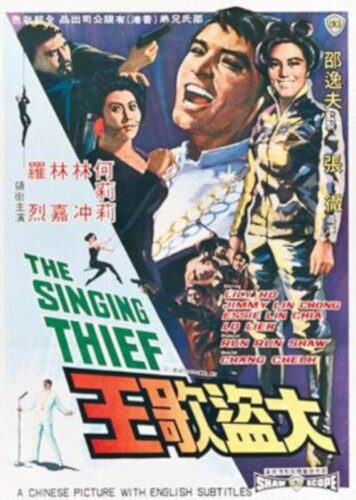
Hong Kong used to be in the grip of a series of jewelry thefts from rich women by a guy named Diamond Poon, who would always leave a red carnation as his calling card, before selling his ill-gotten gains to his friend Gui Ti. Somebody grassed him up to the police and he was imprisoned for six years. Now he’s free and has reinvented himself as a pop singer who has no shame in cheekily recalling his previous “career” on stage. However, a copycat criminal known as the Flying Thief has began to make the headlines, so therefore he’s now under pressure from both a gang boss who wants what he’s supposedly stolen, and the police. Heiress Darling Fang is fascinated with Poon and wants to keep him close despite owning a lot of jewelry herself, while Poon decides to catch this impostor….

The Singing Thief, which is not a particularly good title but which does frankly and succinctly describe our main character, doesn’t appear to be much influenced by the James Bond films at all except perhaps for its suave hero and the air of glamour, though these things certainly hadn’t been exclusive to 007, and this film seems to be far more inspired by crime capers., especially To Catch A Thief, which at times it seems to be a remake of [as did The Return Of The Pink Panther]. This is easily the best made out of the three films, though that’s what you get when you have a set that consists of two offerings which are directed by Lo Wei and one which is directed by Chang Cheh, who was already Shaw’s premiere director of martial arts films and, despite having to basically churn them out, from my [possibly limited] experience did tend to care about what he was making. For about two-fifths of the running time, despite an opening which causes us to think that we’re going to be watching a musical, we’re actually watching a light mixture of thriller and romance with a bit of comedy, and while lacking in action which will disappoint some, it’s nice, easy-going escapism which doesn’t need a fight sequence to be inserted into it every now and again. Then suddenly things change, in a way that Hong Kong cinema would go on to frequently do [this was one of the things which many of those who got into this brand of cinema back in the day really liked], we’re watching a Kung Fu flick with a fair amount of death and blood.
We open in a white and red room with a black-clad man signing about being a expert jewelry thief, before a sleeping woman on a bed while taking whatever treasures are around. He’s then also revealed to be a man on a stage dressed as a pirate, before he goes to a different room where, after we briefly assume his point of view as he’s shining a torch around, we’re in a different room inhabited by another sleeping woman. He takes what’s there, then leaves a red carnation while continuing to sing. After robbing a third woman, the scene changes to a room full of fake diamonds on strings and he sings a second song with lyrics like “Diamonds, diamonds, rigid as steel, like the ruthlessness of a man’s heart, splendidly attired beauties pine at the door, eager to slap his cheeks”. Well, it’s hardly Diamonds Are Forever, though of course it may have lost something in translation, and Lam Chung was a big Taiwanese singer at the time though this might have been expected by cinemagoers at the time. Poon finishes and has a tense encounter out back with a sinister guy. “How was my singing”?, “a bit lacking”, “what do you mean”?, “consider that your last performance as you won’t have the chance to sing any more”, “so you also believe I stole those diamonds”? Poon gets away from him and two other hoods and goes to catch a taxi but in it is Detective Pao, who thinks that the ex-thief is stealing again; Poon says that it must be the work of an imitator. He crashes into a car driven by a lady who tells him off while Poon sneaks away. Then he’s mocked by a large bunch of kids who cry, and not for the only time, “Detective Pao is around when there’s no crisis”. He looks like Lo Wei, but it’s doubtful that he would have played such a incompetent copper; indeed it’s unusual in a Hong Kong movie for the police to be mocked like this.
The woman picks up a red carnation from the ground belonging to be Poon but taken and then dropped by Pao. And she’s hooked! Poon breaks in to the house of his old friend Gui Ti who used to buy his stolen gear off him when he was a thief, but somebody grassed him up and he had to spend six years in prison. Gui is married to Tien Xin who’s a big fan of Poon’s, and the two have a playfight which borders on being positively homoerotic, something that won’t be a surprise for viewers familiar with Cheh-directed movies. Poon asks Gui to find out who the five richest ladies are and give him the list. He thinks that the Flying Thief will go for them, and he will be ready and waiting to catch him. Then the cops grab him, only for him to be released on the orders of Darling Fang, the lady who picked up the carnation, who’s somehow convinced the police to let her be in charge of the case. He encounters Darling while the two are in bumper cars, opening lines being, “What’s the sexiest thing in the world”? “Diamonds”. She says that she has loads of diamonds and wants to see how he’ll steal them, so he can live in her house! Of course what we have here is the To Catch A Thief premise of a woman turned on by a guy because he could be a thief, and the two are soon getting along very fine indeed, though that wonderful erotic tension between Cary Grant’s and Grace Kelly’s characters is only a little bit replicated here. But then, during an awkward double-date meal involving Boon, Darling, Ti and Xin, Xin subtly gives Boon the list he required, which is headed by none other than Darling. Have we guessed the identity of the Flying Thief? I sort of [using those two words “sort of” might sound odd but will become clear if you see the film] guessed, though the plot does have a bit more in store, the movie seeming to come to a climax before it virtually changes genres and continues.
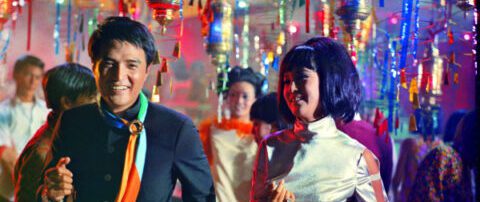
There’s some comic chasing involving Boon and these idiot cops – who comprise Pao and the same exact five guys – who are constantly outwitted, but for much of the time it’s all about quiet escapes and subtle deception, such as when Boon has to get past a hood to his dressing room and throws a coin towards a grain to not just distract him but make him think that the coin is his. The scenes between and the dogged but easily fooled Detective aren’t side-splittingly funny, but they are amusing. Seeing Boon and Darling ambling across her huge garden in slow motion might have been unnecessary, but then this is mostly a frothy affair anyway which surely has room for some usage of cliches, though things eventually change as Boon is repeatedly attacked by bad guys, and we get by far the best choreography out of the three films, courtesy of Tang Chia and the legend that’s Liu Chia Liang, who probably and understandably devoted more time and energy to the likes of Return Of The One-Armed Swordsman and Golden Swallow, but who still give us some decent brawls in a garden, a workshop, up and on top of scaffolding, and in a museum -or is a film set? If it’s the latter then the film is being almost Meta. Familiar sets are seen, weapons such as hooks and spades are employed, even the environment is sometimes taken advantage of [look out for some very cool early Jackie Channery in the museum battle involving a table and a trolley], bad guys die bloodily and blows actually look like they’re hitting their targets, though Chung has obviously not received detailed martial arts training and the staging occasionally struggles to successfully disguise this, even when it takes place in dark settings in scenes which must have looked rather poor in earlier formats. But folks rather disappointed in the brawls in the other two films will be more satisfied with what’s on offer here, even if the main bad guy – a certain Lo Lieh – is defeated very quickly.
Apart from a really sudden change from nighttime to daytime, and the possible inclusion of a daft scene where our hero is clambering about right above people in a restaurant who would have clearly noticed him, The Singing Thief doesn’t have any of the slapdash stuff that one can find in The Golden Buddha and Angels With The Iron Fist, which is good, but nor does it have much of the craziness which sometimes came along in those two films, which might not be good to some, but then the intention was clearly to make a reasonably western-style film, at least for a fair bit of the running time, and Cheh, coming off Golden Swallow, seems really engaged. Screenwriter Chiu Kang-Chien has created a reasonable plot which, despite its derivative nature, brings in a few newish turns. though it’s impossible to get one’s head round the idea of the police willingly handing over an important case to the charge of a woman just because she’s an heiress, even if one accepts that the cops are total idiots in this movie. Lily Ho does what she can with her rather daft character, but more dramatic moments are given to Chia Essey Lin, who plays Xin, even if the script isn’t that clear on Xin’s connection to Boon. It seems that she once had a relationship with him, though we have to work this out for ourselves until a climactic revelation, and has become rather obsessed, though Boon’s reaction to her watching concert footage probably taken illicitly – even though it looks like professional filmmaking shot by several and properly edited [why do so many films make this really stupid mistake?] – then firing a gun at the projector screen, is amazingly calm. In fact Lin Chong, who even winks at the audience, is sometimes a bit tiresome with his grinny devil-may-care attitude to virtually everything, though he certainly has screen presence to spare. He slightly resembles Chow Yun-Fat, an actor who one can actually see in this role, at least in his younger days.
I didn’t recognise any pilfered music in the musical score, which is again credited to Wang Fu-Ling, though the exaggerated comic music for the police chasing Boon sounds rather different to the rest of the soundtrack, which is certainly serviceable but lacks a real main theme which would have helped our investment in the central romance. The action in the final third is largely unscored. Certain elements in The Singing Thief don’t seem quite fully developed, but, despite it being low on action for a great deal of its running time, I feel it’s overall the best out of these three films – even if, as I said earlier, it’s a bit short on craziness.
New audio commentary by action cinema experts Mike Leeder and Arne Venema
Leeder’s opening questions to Venema set the tone. “Have you ever snuck around a woman’s apartment with a cape pulling out red carnations? Did you ever dress as a Spanish pilot and decide to sing about it?” Leeder also tells us that the theme park seen was rebuilt for the film Chasing The Dragon which originally intended to set its climax there including the using of a two-man elephant suit [he was there], why he once visited a Love Hotel with Tsui Hark which was robbed by two guys pretending to be cops while nobody called the actual cops because they didn’t want to be emnarassed, and notices that the same huge trampoline shows up in two places, and facts about people involved such as editor Hsing-Loong Chiang having edited a whopping 640 films, while Venema tells us that there was certainly a drug culture in Hong Kong at the time but it involved mainly heroin, about a singer who received a death threat just like the one Boon gets, and that John Woo was influenced by musicals. The two are truly on top form in these three commentary tracks.
From Hong Kong With Love – Wayne Wong [editor of Martial Arts Studies] on spy films at Shaw Brothers [16 mins]
Wong perhaps strains a bit when he relates things like the obeying of orders in the first two of these films to political stuff that was taking place at the time, but nonetheless gives us a decent look at these movies which he says were “a continuation of a tradition with some innovation”, and belonged to a period where Shaw Brothers often brought in Korean and Japanese directors in an effort to modernise their product. He reinforces my continual argument that strong women in action cinema were nothing new if you look at Far Eastern movies.
International Super Spies – James Bond expert Llewella Chapman on Bondmanioa in the’60s [22 mins]
I already knew a bit about this area of cinema, but Chapman’s piece will certainly intrigue a lot of watchers not familiar with it, while she’s very good on what made Bond so popular; she traces the release of Goldfinger, which is when Spymania exploded, to the publication of lots of travel articles in magazines, while she also emphasises that Bond-related merchandise was certainly not limited to toys and mentions a particularly amusing example which probably wouldn’t fly today. The Bond character is perceptively described as “easy to imitate and parody” , before we’re treated to some examples and a go-through of the three Shaw films in this set. By the time of the last one, the formula had become familiar so Spymania slowed down.
SPECIAL FEATURES
Limited Edition (2000 Copies)
Limited edition O-Card slipcase featuring new artwork by Darren Wheeling
1080p HD presentations on Blu-ray from masters supplied by Celestial Pictures
Every single one of the Shaw Brothers restorations I’ve seen – and there have been a lot recently [we’re now on Volume Three of the Arrow Films Shaw boxsets] – have looked great. I doubt that Eureka have ever felt the need to do their own modifications regarding these. Celestial Pictures seem to do a truly amazing job. All three films here look simply fabulous, with eye-popping colours, impressive detail and realistic skin notes – oh and the fabulous look to one particular very dark action sequence in The Singing Thief which exhibited no black crush whatsoever. Continue to be impressed.
Original mono audio tracks
It’s doubtful that these films were ever dubbed into English, though I can imagine them with the typical Shaw dubbing….
Optional English subtitles, newly translated for this release
Reversible sleeve featuring individual sleeve artwork for each film
A limited edition collector’s booklet featuring new writing on all three films by Iain Robert Smith, author of The Hollywood Meme: Transnational Adaptations in World Cinema
I’m going to honestly admit that none of the films in this set were that great to this critic – even the third which is the one I found to be the best – but they belong to a very interesting area of cinema and I did still highly enjoy them. These are exactly the kind of films that I’d put on after a stressful day at work! A big shout out to audio commentary gods Mike Leeder and Arne Venema is required; perhaps, more than ever before, their commentary tracks compliment the films that they’re supporting, increasing both enjoyment and understanding while never pretending that they’re cinematic masterpieces. Recommended!





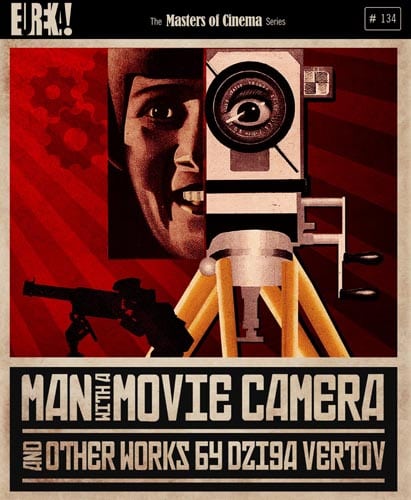
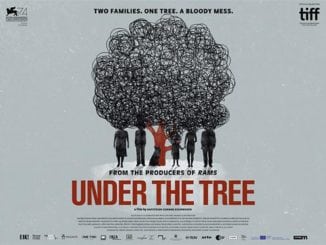
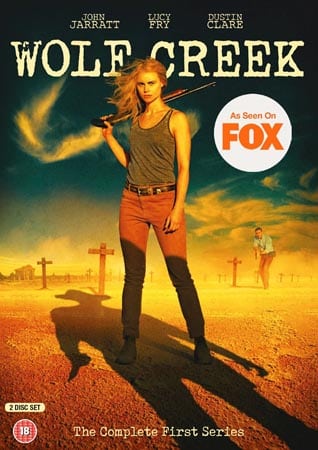
Be the first to comment